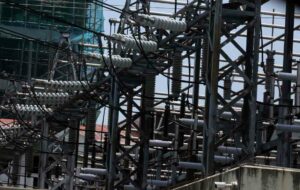Apple Announces Significant Decline in iPhone Sales, Unveils Upcoming AI Strategy
Philippines’ main grids placed under red, yellow alerts

By Ashley Erika O. Jose, Reporter
THE PHILIPPINES’ main grids on Wednesday experienced a shortfall of energy supply for the seventh time this month, with a yellow alert being raised over the Mindanao power grid for the first time in 2024.
In a statement, the National Grid Corp. of the Philippines (NGCP) placed Mindanao under yellow alert status from 10 a.m. to 4 p.m. after nine plants in the region went offline, while five have been running on derated capacities. This resulted in the unavailability of 673.98 megawatts (MW) to the grid.
NGCP said this is the first time Mindanao was placed under yellow alert status so far this year as the region usually has a power surplus. The yellow alert status in Mindanao was lifted at 3:09 p.m.
Yellow alerts are issued when the supply available to the grid falls below a designated safety threshold. If the supply-demand balance deteriorates further, a red alert is declared.
The Luzon and Visayas power grids were again placed under red and yellow alert status on Wednesday, the grid operator said.
Red alert status was raised over Luzon grid from 3 p.m. to 4 p.m., while yellow alert was issued from 4 p.m. to 10 p.m., NGCP said, adding that power demand in Luzon reached 14,016 MW against the available capacity of 14,249 MW.
Data provided by NGCP said Luzon hit a peak demand of 14,016 MW on Wednesday, the highest so far for the year. The previous high was recorded on Tuesday at 13,864 MW.
Four power plants went offline in Luzon while two are running on derated capacities, resulting in a total of 1,840.3 MW unavailable to the grid.
As of 4:05 p.m., the NGCP lifted the red alert over Luzon but the grid was still under yellow alert status from 4 p.m. to 11 p.m.
Meanwhile, Manila Electric Co. (Meralco) said it had advised the participants of its Interruptible Load Program to be on standby. These are large power consumers that have their own generating facilities. These entities stop drawing power from the grid during times of unreliable supply, reducing the overall load on the grid.
“If necessary, we are ready to implement manual load dropping as part of our responsibility to manage the system,” Meralco said in a Viber statement.
The Visayas grid was placed under red alert status from 12 p.m. to 5 p.m., and from 6 p.m. to 8 p.m., while the yellow alert status was issued from 10 a.m. to 12 p.m., 5 p.m. to 6 p.m., and 8 p.m. to 9 p.m.
Three power plants were on forced outage in the Visayas grid, while eight plants were running on derated capacities for a total of 621.6 MW capacities unavailable to the grid.
“The reduced capacity exported by Mindanao to Visayas also aggravated the power situation in Visayas,” NGCP said.
NGCP said it had implemented manual load dropping or rotational brownout from 3 p.m. to 4 p.m. in the province of Abra, parts of Tuguegarao City, Cagayan, parts of Albay, and parts of Bataan and Batangas.
“In the ICSC (Institute for Climate and Sustainable Cities) study, we assumed a 100-MW allowance in the forced outage for Mindanao, which is a conservative assumption based on the average historical outages of Mindanao. However, in (Wednesday’s) actual grid operations, we are seeing that the capacities in forced outage and derated operation have exceeded this assumption,” Jephraim C. Manansala, chief data scientist at the ICSC, said in a Viber message.
Mr. Manansala said hydroelectric power plants are expected to have lower output during the summer months especially with the El Niño weather phenomenon.
“However, the untimely unavailability and deration of other plants such as coal have made the situation alarming,” he said.
ICSC said the country is expected to experience a shortfall of power supply “indefinitely” for as long as power plants continue to run on derated capacities.









